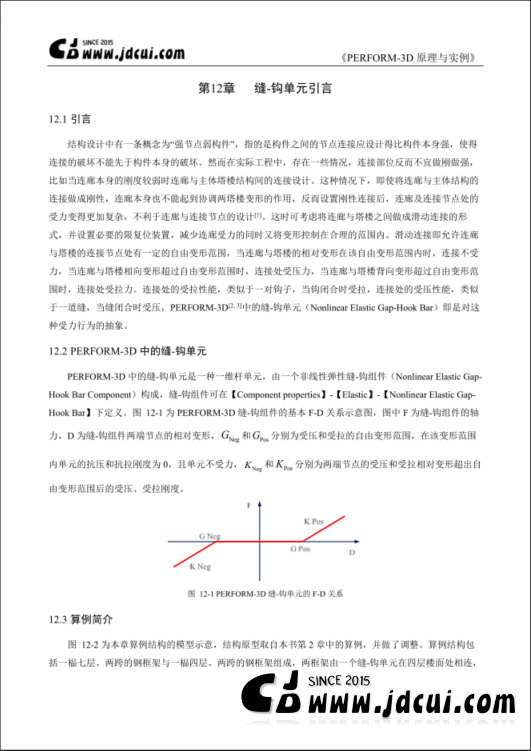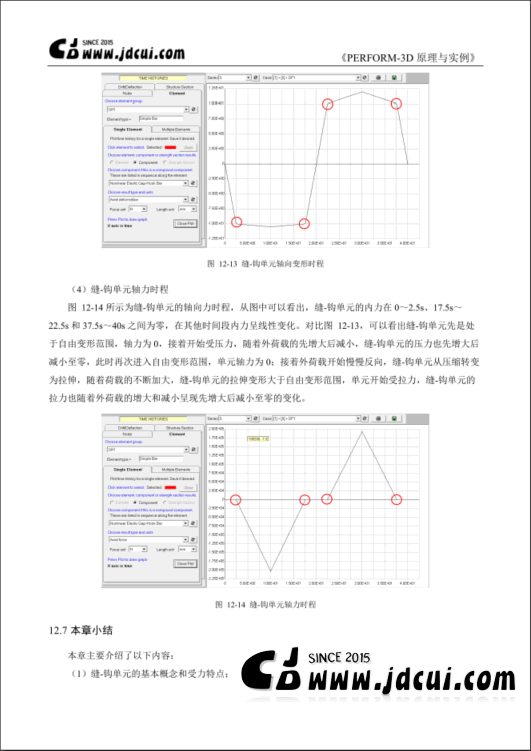[书]PERFORM-3D原理与实例 – 第 12 章 – 缝-钩单元
[Book] PERFORM-3D Theory and Tutorials – Chapter 12 – Gap-Hook Element
- 章节内容简介 [ Chapter Content Abstract ]
结构设计中有一条概念为“强节点弱构件”,指的是构件之间的节点连接应设计得比构件本身强,使得连接的破坏不能先于构件本身的破坏。然而在实际工程中,存在一些情况,连接部位反而不宜做刚做强,比如当连廊本身的刚度较弱时连廊与主体塔楼结构间的连接设计。这种情况下,即使将连廊与主体结构的连接做成刚性,连廊本身也不能起到协调两塔楼变形的作用,反而设置刚性连接后,连廊及连接节点处的受力变得更加复杂,不利于连廊与连接节点的设计[1]。这时可考虑将连廊与塔楼之间做成滑动连接的形式,并设置必要的限复位装置,减少连廊受力的同时又将变形控制在合理的范围内。滑动连接即允许连廊与塔楼的连接节点处有一定的自由变形范围,当连廊与塔楼的相对变形在该自由变形范围内时,连接不受力,当连廊与塔楼相向变形超过自由变形范围时,连接处受压力,当连廊与塔楼背向变形超过自由变形范围时,连接处受拉力。连接处的受拉性能,类似于一对钩子,当钩闭合时受拉,连接处的受压性能,类似于一道缝,当缝闭合时受压,PERFORM-3D[2, 3]中的缝-钩单元(Nonlinear Elastic Gap-Hook Bar)即是对这种受力行为的抽象。
- 示例页面 [ Sample Pages ]


PS. 如有错误,请批评指正。如果你喜欢,请在上面 点个赞 吧!!详细内容请阅读书本!! 🙂 🙂 🙂
( Please correct me if I’m wrong. If you like this posts, please give me a “thumbs up” rating on the button above! For more information about this Chapter please refer to the book!! 🙂 🙂 )
- 购书链接 [ Links to Buy the Book ]
[1] 中国建筑出版在线(http://book.cabplink.com)
http://book.cabplink.com/bookdetail.jsp?id=64317&nodeid=1439
[2] 京东(www.jd.com)
https://item.jd.com/12084377.html (自营)
https://item.jd.com/12860783272.html
https://item.jd.com/12860780755.html
[3] 当当网(http://www.dangdang.com/)
http://product.dangdang.com/1260359350.html
[4] 亚马逊 (https://www.amazon.cn/)
coming soon…..
[5] 天猫书城 (https://www.tmall.com/)
- 相关链接[ Acknowledgements ]
[01] 书《PERFORM-3D原理与实例》 汇总页面 (PERFORM-3D Theory and Tutorials Book Page ) (书本主页)
[02] [Book][PERFORM-3D Theory and Tutorials — Table of Contents] [目录英文版]
[03] [Book][PERFORM-3D Theory and Tutorials – Foreword ] [前言英文版]
[11] [书]PERFORM-3D 原理与实例 – 第 8 章 – 粘滞阻尼器 ( PERFORM-3D Theory and Tutorials – Chapter 8: Viscous Damper )
- 微信公众号 ( Wechat Subscription)
欢迎关注 “结构之旅” 微信公众号,及时订阅更新

![Grasshopper建筑结构参数化建模应用实例[Practical Examples of Parametric Modeling for Building Structures Using Grasshopper]](http://www.jdcui.com/wp-content/uploads/2026/01/封面.png)